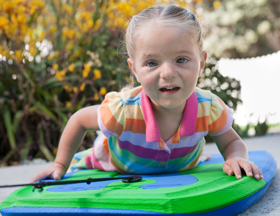
Two-year-old Lauren Lowary was born with what was thought to be a run-of-the-mill birthmark. Specialists at Rady Children’s discovered a far more serious condition.
When Lauren Lowary was born with a large red mark on her face, her mom, Susan, didn’t think much of it — until it changed.
“We watched it for a few weeks, hoping it would fade,” Susan said. “Instead, it got thicker, and the color changed from red to purple.”
Susan became more concerned when Lauren’s pediatrician — during a routine check-up — mentioned referring her case to a dermatologist. And when the Lowarys got home from the visit, there was a message from the Dermatology Division at Rady Children’s Hospital-San Diego notifying them of Lauren’s upcoming appointment. The speed of the call added to Susan’s fear — that what she initially thought was a bruise or run-of-the-mill birthmark was something far more troubling. Soon, the Lowarys would be making countless trips to Rady Children’s.
Lauren was diagnosed with a segmental hemangioma, a rare and potentially worrisome skin growth. Each year, up to 10 percent of infants in the United States are either born with or develop hemangiomas within their first year of life; they are one of the most common birthmarks seen in newborns. Typically, these birthmarks shrink and fade over time, without lasting issues, but large segmental lesions can signal more serious medical problems.
After seeing Sheila Friedlander, M.D., a dermatologist and co-director of the Vascular Lesion and Birthmak Center at Rady Children’s, Lauren had a magnetic resonance angiography exam — a special type of magnetic resonance imaging (MRI) test — and was referred to a cardiologist, ophthalmologist and neurologist at the Hospital. Tests revealed that she had PHACE syndrome, a disease in which a large hemangioma is associated with one or more other abnormalities. In Lauren’s case, she was missing her right carotid artery, a major artery in the neck that supplies blood to the brain.
“We really thought she was going to have a stroke or maybe even die because of the missing carotid artery,” Susan said.
Fearing the worst, Susan and her husband, Michael, made an appointment for a consultation with Michael Levy, M.D., director of Pediatric Neurosurgery at Rady Children’s. To their relief, Dr. Levy explained that Lauren’s body had adapted to the lack of blood flow on her right side.
To help reduce the size of the hemangioma, Lauren was put on high-dose steroids at about 3 months old. But this didn’t work; in fact, the growth that covered approximately 90 percent of her face was causing serious problems: she had trouble breathing, she couldn’t breastfeed, and she was in danger of losing her eyesight. And as the hemangioma continued to grow, Lauren’s lip started to split. Dr. Friedlander and Lauren’s parents knew they needed to take a different approach.
Dr. Friedlander suggested treatment with propranolol, a beta-blocker used primarily for lowering blood pressure. In 2008, physicians in France discovered that the drug worked in shrinking hemangiomas in a group of patients (with hemangiomas) who were being treated for hypertension.
“It really was a serendipitous discovery,” Dr. Friedlander said. “Propranolol has been used for a long time to treat hypertension and appears to have very few side effects, so there is a lot of excitement about what it can do for children with hemangiomas, without the potential and often severe side effects we see with steroid therapy.”
There are currently no treatments approved by the U.S. Food and Drug Administration for hemangiomas. The most common therapies used are steroids or vincristine, a chemotherapy drug.
“We knew that we didn’t want Lauren started on the vincristine,” Susan said. “So when Dr. Friedlander told us about the propranolol, we told her to ‘go for it!’ We didn’t know what else to do. She was having trouble breathing, eating and seeing. We needed to do something.”
Within one week of starting the propranolol, Lauren’s family saw dramatic results. The hemangioma had finally stopped growing, and they could see a noticeable difference in its appearance.
While taking the medication, Lauren also received pulsed dye laser therapy. This type of laser therapy treats the most superficial parts of the hemangioma — the flat red lesions on the surface of the skin.
“The difference in Lauren’s appearance is remarkable,” Susan said. “Everyone at Rady Children’s worked well together to ensure that Lauren had the best possible outcome. I believe God put people around us to get us through this difficult time and that includes the people at Rady Children’s and at our church, Newbreak.”
Last year, Lauren was diagnosed with glaucoma, a progressive eye disease that can cause blindness. It is not known whether the disease resulted from the steroid medication or from PHACE syndrome. Since her diagnosis, Lauren has been under the care of Colin Scher, M.D., director of Ophthalmology at Rady Children’s, and has had several procedures to reduce fluid build-up in her left eye. At one point, the hemangioma — in combination with the steroids — caused pressure in the eye to be so severe that her parents thought she was going to lose her vision.
Lauren continues to be treated for the glaucoma and hemangioma, and will most likely need treatment for the glaucoma for the rest of her life. Despite these conditions — and all she has been through — the 2-year-old is on track developmentally and has no problem keeping up with her siblings: twin sister, Sydney, and big brother, Chase.
Her parents believe that being a twin has helped Lauren to make great strides. “She does whatever it takes to keep up with Sydney,” Susan said.
Rady Children’s is currently participating in an international study to evaluate the effectiveness and safety of propranolol for hemangiomas. For more information, please contact Rady Children’s Dermatology Research Coordinator at 858-576-1700, ext. 224295.
The San Diego Union-Tribune Kids’ Newsday, October 2010